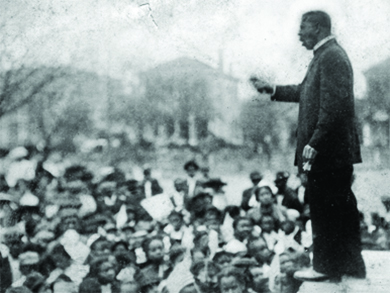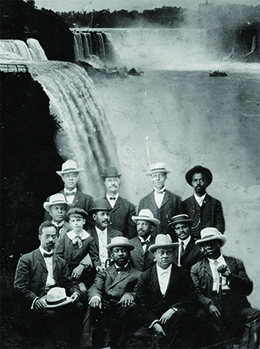| << Chapter < Page | Chapter >> Page > |

Visit George Mason University’s History Matters website for the text and audio of Booker T. Washington’s famous Atlanta Compromise speech.
Yet, many African Americans disagreed with Washington’s approach. Much in the same manner that Alice Paul felt the pace of the struggle for women’s rights was moving too slowly under the NAWSA, some within the African American community felt that immediate agitation for the rights guaranteed under the Thirteenth, Fourteenth, and Fifteenth Amendments, established during the immediate aftermath of the Civil War, was necessary. In 1905, a group of prominent civil rights leaders, led by W. E. B. Du Bois, met in a small hotel on the Canadian side of Niagara Falls—where segregation laws did not bar them from hotel accommodations—to discuss what immediate steps were needed for equal rights ( [link] ). Du Bois, a professor at the all-black Atlanta University and the first African American with a doctorate from Harvard, emerged as the prominent spokesperson for what would later be dubbed the Niagara Movement . By 1905, he had grown wary of Booker T. Washington’s calls for African Americans to accommodate white racism and focus solely on self-improvement. Du Bois, and others alongside him, wished to carve a more direct path towards equality that drew on the political leadership and litigation skills of the black, educated elite, which he termed the “talented tenth.”

At the meeting, Du Bois led the others in drafting the “Declaration of Principles,” which called for immediate political, economic, and social equality for African Americans. These rights included universal suffrage, compulsory education, and the elimination of the convict lease system in which tens of thousands of blacks had endured slavery-like conditions in southern road construction, mines, prisons, and penal farms since the end of Reconstruction. Within a year, Niagara chapters had sprung up in twenty-one states across the country. By 1908, internal fights over the role of women in the fight for African American equal rights lessened the interest in the Niagara Movement. But the movement laid the groundwork for the creation of the National Association for the Advancement of Colored People ( NAACP ), founded in 1909. Du Bois served as the influential director of publications for the NAACP from its inception until 1933. As the editor of the journal The Crisis , Du Bois had a platform to express his views on a variety of issues facing African Americans in the later Progressive Era, as well as during World War I and its aftermath.
In both Washington and Du Bois, African Americans found leaders to push forward the fight for their place in the new century, each with a very different strategy. Both men cultivated ground for a new generation of African American spokespeople and leaders who would then pave the road to the modern civil rights movement after World War II.
The Progressive commitment to promoting democracy and social justice created an environment within which the movements for women’s and African American rights grew and flourished. Emergent leaders such as Elizabeth Cady Stanton, Susan B. Anthony, Carrie Chapman Catt, and Alice Paul spread the cause of woman suffrage, drawing in other activists and making the case for a constitutional amendment ensuring a woman’s right to vote. African Americans—guided by leaders such as Booker T. Washington and W. E. B. Du Bois—strove for civil rights and economic opportunity, although their philosophies and strategies differed significantly. In the women’s and civil rights movements alike, activists both advanced their own causes and paved the way for later efforts aimed at expanding equal opportunity and citizenship.

Notification Switch
Would you like to follow the 'U.s. history' conversation and receive update notifications?